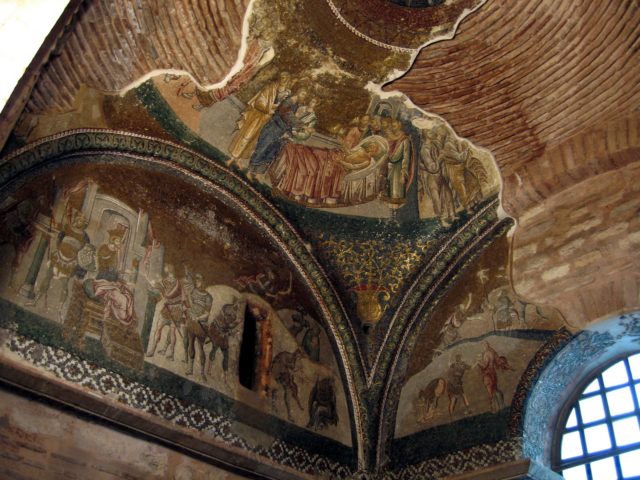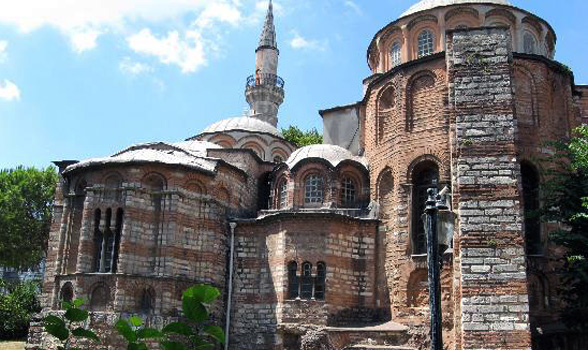Visions of Byzantium
The exhibition, Vaults of Heaven Visions of Byzantium, presents a series of extraordinary ultra-large-scale photographs, many over six-feet tall, by the renowned Turkish photographer Ahmet Ertug. The exhibit is at the Kelsey Museum of Archeology at the University of Michigan through Jan. 23. Focusing on paintings, mosaics, and architecture of the Byzantine world (6th–14th centuries AD), the photos provide a journey through such venerated sites as Istanbul’s Hagia Sophia and Church of Christ in Chora, as well as churches in the Cappadocia region of central Turkey, an area known for hidden Christian retreats hewn out of the region’s unusual volcanic rock formations. Trained as an architect, Ahmet Ertug combines a deep understanding of Byzantine history and culture with an artist’s eye. His remarkable photographs capture the mystery and power of these ancient sites, offering viewers intimate views of the great domes, expansive structural details, and exquisite mosaics and paintings of these sacred spaces. Accompanying the photographs are objects from the Kelsey Museum’s collections of Byzantine and Islamic material, including gold coins, manuscripts pages, small carvings, pottery, and wooden architectural fragments. ![]() Vaults of Heaven Visions of Byzantium will be displayed in two parts. Part I, on display from Oct. 1– Jan. 23, 2011, includes visions from two famous metropolitan churches in Istanbul: Hagia Sophia and the early 14th-century Church of Christ in Chora. Part II, on display from Feb.4 – May 29, 2011, focuses on Karanlik, a monastic compound built in the 11th century; Tokali, the largest church in Cappadocia, with paintings from the 10-11th centuries and the church of Meryemana (“Mother Mary”), which is currently closed to the public. Ahmet Ertug has been hailed as one of the world’s few living photographers who is “predestined to become a part of history.” His extraordinary images have been featured in major exhibitions from Japan and Turkey to Paris and London. A selection of his work is permanently displayed in the upper gallery of Istanbul’s famous Hagia Sophia.
Vaults of Heaven Visions of Byzantium will be displayed in two parts. Part I, on display from Oct. 1– Jan. 23, 2011, includes visions from two famous metropolitan churches in Istanbul: Hagia Sophia and the early 14th-century Church of Christ in Chora. Part II, on display from Feb.4 – May 29, 2011, focuses on Karanlik, a monastic compound built in the 11th century; Tokali, the largest church in Cappadocia, with paintings from the 10-11th centuries and the church of Meryemana (“Mother Mary”), which is currently closed to the public. Ahmet Ertug has been hailed as one of the world’s few living photographers who is “predestined to become a part of history.” His extraordinary images have been featured in major exhibitions from Japan and Turkey to Paris and London. A selection of his work is permanently displayed in the upper gallery of Istanbul’s famous Hagia Sophia.
Roald Dahl’s daughter finds peace as a nun A 1974 graduate of the Architectural Association School of Architecture in London, Ertug began his photographic career in 1972, taking pictures of Caribbean festivals and street life in London. Although he continued to work as an architect, his interest in photography grew throughout the 1970s. While working in Iran, he began photographing indigenous settlements and ancient Persian monuments, and in 1979, with the help of a research grant, he traveled throughout Japan, capturing images of ancient Japanese temples, Zen gardens, and festivals. After his year in the Far East, Ertug returned to Istanbul, having been hired as an architect for the conservation planning of the city. His increasingly intimate knowledge of the city’s historic quarters inspired him to begin photographing Istanbul’s impressive Byzantine, Ottoman, and Roman remains, using a large-format camera that enabled him to capture their full splendor. In the 1980s, Ertug established his own publishing house, producing specially designed books of his photographs that are now recognized for their innovation in the printing industry. Both his books and photographs have been internationally praised for their beauty and “deep meditative energy,” which draw the viewer into his subject.
The Kelsey Museum of Archeology is located at 434 S. State Street, Ann Arbor. (734)-764-9304; www.lsa.umich.edu/kelsey Todd Gerring is community outreach coordinator at the Kelsey Museum of Archeology



